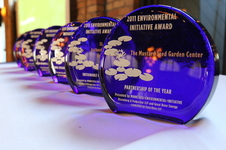|
In this issue:
- MPCA permit streamlining
- NESHAP updates: 6H and 6X
- MEI Award Winner: Mustard Seed Garden Center
- Governors Award Winner: Public Pools Initiative
- Events
- Enterprise survey - Share your story!
|
|
 |
The MPCA currently receives about 5,000 permit applications
every year. These applications can be confusing and complicated, and many of
them are submitted without all the required information. This can result in
delays in processing applications and issuing permits. In the past, the MPCA
addressed this issue by focusing limited resources on priority applications,
such as new construction projects.
As of July 1, new legislation requires the MPCA to determine
within 30 days whether all permit applications are substantially complete. If
the application is deemed not substantially complete, the MPCA must advise the
applicant how the deficiencies can be remedied. If the MPCA does not notify the
project proposer within 30 days, the application is automatically deemed
complete.
This is a significant change in the way the MPCA has
traditionally handled applications. Since the MPCA manages over 18,000 permits,
and every reissuance, amendment, or additional permit needs an application, the
ramifications are wide-ranging. These changes will certainly present challenges
for both the MPCA and the regulated community. However, we are confident that working
together to improve the quality of permit applications will result in faster
permits while still protecting human health and the environment. Please see the
MPCA Permits and Forms webpage for more
information.
Subpart 6X – Metal Fabrication and
Finishing
The U.S. EPA issued an air regulation that affects 9
categories of metal fabrication and finishing facilities. This rule, referred
to as NESHAP Subpart 6X, applies to facilities that meet the following four
characteristics:
-
They are an area source (potential emissions are less
than 10 tons/yr of a single hazardous air pollutant (HAP) or less than 25
tons/yr of total combination of HAPs);
-
They have a specific Standard Industrial Classification
(SIC) and North American Industrial Classification System (NAICS) code
combination (see Sidebar);
-
They must be “primarily engaged” (50 percent or more)
in the activities described by the SIC/NAICS code combination; and
- The facility must also use or have emissions of the
following metal HAPs: cadmium, chromium, lead, manganese, and nickel.
Subpart 6H – Paint Stripping and
Miscellaneous Surface Coating
If a facility is not subject to Subpart 6X, it might be
subject to a different rule called Subpart 6H or Miscellaneous Surface Coating
NESHAP. This rule affects any of the following facilities:
-
Paint stripping operations that use
methylene chloride-containing paint stripping formulations
-
Spray application of coatings to
motor vehicles and mobile equipment
- Spray application of coatings to a
plastic and or metal substrate where the coatings contain compounds of
chromium, lead, manganese, nickel, or cadmium.
Important -- Determining SIC/NAICS code combination
- SIC codes that apply to your facility can be listed on your
federal tax form--the codes are typically located on the upper left of the
Schedule C or C-EZ for Sole Proprietors, Form 1065 for Partners, Form 1120 for
C Corporations, or Form 1120-S for S Corporations.
|
Partnership of
the Year
The Environmental Initiative Awards annually
recognize innovative projects that have harnessed the power of partnership to
achieve extraordinary environmental outcomes. Winners were announced in May
during the Awards dinner at the Nicollet Island Pavilion. In addition to
evaluation by an independent panel of judges, five hundred community members
voted online to select one of the fifteen finalists as the 2011 Partnership of
the Year, with an incentive award of $1000. The Mustard
Seed Garden Center won that nomination.
|
|
 |
The Mustard Seed Garden Center, a
small business located on 27 acres of rolling farmland in Chaska, has built a
garden center that has become an excellent example of, and proactively teaches,
environmental stewardship. They have an attractive and functional
business, proving that business stewardship leads to success through community
giving and partnerships.
Results
The Mustard Seed retains
stormwater runoff onsite and channels it through a 600 foot raingarden before it
enters the first of two sediment control ponds that store the water for
irrigation. They stocked the ponds with fish and plants to create a balanced
ecosystem. Their "shrub lot" is covered with pea gravel and other permeable
pavers to facilitate infiltration, while a water garden nestled decoratively
collects roof run-off. They use 100 percent of their water for irrigation and
found they need less fertilizer as a result.
Geosource Heat Pumps provide all
heating and cooling and extra pump water is discharged into the ponds for
irrigation. The extra heat generated by the compressors is used in the water
heater. They use high-efficiency bulbs, off-peak energy from MVEC and have an
"ultra high efficiency" water heater. Their building far exceeds
minimum energy efficiency requirements and greenhouses receive maximum solar
gain while being placed to be sheltered from prevailing winds. Mustard Seed is now installing a 39.9kW 160’
tall wind turbine that will provide more than 100 percent of their electrical
demand.
All of Mustard Seed’s cardboard
and used plastic pots are recycled, all organic waste is composted, and
remaining trash is sorted, recycled and/or burned to produce electricity by
their garbage hauler. The display benches in their greenhouse are made from
recycled plastic.
They host free field trips with
learning stations on Wellness, Horticulture, Animal Husbandry, Apiculture,
Composting, and Renewable Energy! They anticipate over 1,200 students will
participate. They also conduct seminars
that teach water resource protection and have collaborated with Grow.Eat.Share
to create a community garden on-site where children learn the joys of gardening
while being taught healthier lifestyles. The kids even use the kitchen to cook
fresh vegetables for lunch.
Congratulations
to Mark and Kay Halla of The Mustard Seed Garden Center (pictured above)!
The MPCA’s Governor's Awards for
Pollution Prevention recognize Minnesota's businesses, nonprofits, and
institutions that demonstrate a superior commitment to waste and pollution
prevention, source reduction and resource conservation. The City of St. Paul,
Creative Water Solutions, and USAquatics recently won this year in the
Partnership category.
The City of St. Paul
worked with Creative Water Solutions and USAquatics to develop an alternative
to chlorinating public swimming pools. The pilot project was started at
the Highland Park Aquatic Center and used a species of sphagnum moss as a
filtration device. It was the first use of moss as a water conditioning
and treatment agent in a public pool anywhere in the world. The project
has subsequently been replicated with similar results at several pools in the
Twin Cities area including Great River Water Park, select Minneapolis public
pools, and the St. Louis Park Rec Center.
Benefits
The moss filtration system reduced chlorine and bicarbonate use
by more than 50 percent, and cyanuric acid is no longer needed for
sanitation. This project also resulted in less need to backwash the pool,
saving about 30,000 gallons of water every two weeks.
The City of St. Paul has saved $36,000 in chemical costs
annually, and $40,000 in salary for staff overtime since the inception of the
project. The sphagnum moss system also proved to be an effective marketing tool
for the Highland Park Aquatic Center. Overall, the city realized a $100,000
increase in revenues at the pool in 2009, which was attributed to the new moss system.
Congratulations
to the City of St. Paul, Creative Water Solutions, and USAquatics!
The MPCA’s Governor's Awards for
Pollution Prevention recognize Minnesota's businesses, nonprofits, and
institutions that demonstrate a superior commitment to waste and pollution
prevention, source reduction and resource conservation. The City of St. Paul,
Creative Water Solutions, and USAquatics recently won this year in the
Partnership category.
The City of St. Paul
worked with Creative Water Solutions and USAquatics to develop an alternative
to chlorinating public swimming pools. The pilot project was started at
the Highland Park Aquatic Center and used a species of sphagnum moss as a
filtration device. It was the first use of moss as a water conditioning
and treatment agent in a public pool anywhere in the world. The project
has subsequently been replicated with similar results at several pools in the
Twin Cities area including Great River Water Park, select Minneapolis public
pools, and the St. Louis Park Rec Center.
Benefits
The moss filtration system reduced chlorine and bicarbonate use
by more than 50 percent, and cyanuric acid is no longer needed for
sanitation. This project also resulted in less need to backwash the pool,
saving about 30,000 gallons of water every two weeks.
The City of St. Paul has saved $36,000 in chemical costs
annually, and $40,000 in salary for staff overtime since the inception of the
project. The sphagnum moss system also proved to be an effective marketing tool
for the Highland Park Aquatic Center. Overall, the city realized a $100,000
increase in revenues at the pool in 2009, which was attributed to the new moss system.
Congratulations
to the City of St. Paul, Creative Water Solutions, and USAquatics!
BUSINESS & ENVIRONMENT SERIES: Practicing Product Stewardship: Drivers, Challenges and Strategies
Moving beyond internal sustainability initiatives, companies are now
working comprehensively to address environmental impacts through their supply
chains and product life cycles. Building on previous
discussions, this session will make it easier to assess and minimize your
products’ environmental impacts throughout the entire value chain. For more information visit the Environmental Initiative website.
Tuesday, October 25, 2011
8:30 a.m. - 1:30 p.m.
Best Buy Co, Inc.
7601 Penn Avenue South
Minneapolis, MN 55423
|